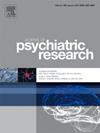评估急诊室收治的药物自杀病例中的 MMP-9 酶
IF 3.7
2区 医学
Q1 PSYCHIATRY
引用次数: 0
摘要
方法 研究对象包括 45 名急诊室收治的大剂量服药自杀未遂患者和 45 名无神经精神疾病的健康志愿者。研究人员采集了血液样本以测量 MMP-9 水平,并获得了知情同意。结果表明,单身和学生会显著增加自杀倾向(分别为 p = 0.002 和 p = 0.001)。精神障碍是最常见的自杀原因,占 40.0%,其次是抗抑郁药(55.6%)、镇痛药(20.0%)和抗糖尿病药(8.9%)。与对照组相比,自杀未遂患者的MMP-9水平明显更高(83.74 (±7.14) ng/mL vs. 54.97 (±12.27) ng/mL,p = 0.001)。此外,与已婚或离婚者相比,单身患者的 MMP-9 水平更高(p = 0.008)。结论这项研究表明,MMP-9酶可作为药物诱发自杀未遂的潜在生物标志物,强调了评估MMP-9水平对评估自杀风险和制定预防策略的重要性。本文章由计算机程序翻译,如有差异,请以英文原文为准。
Evaluation of MMP-9 enzyme in drug-induced suicide cases admitted to the emergency room
Objective
This study investigates MMP-9 enzyme levels in patients who attempted suicide by taking high doses of drugs, considering their sociodemographic characteristics.
Methods
The study included 45 patients who attempted suicide by high-dose drug intake admitted to the emergency room and 45 healthy volunteers with no neuropsychiatric disorders. Blood samples were collected to measure MMP-9 levels, and informed consent was obtained. The samples were centrifuged and analyzed using the ELISA method, with results statistically compared.
Results
Findings indicate that being single and a student significantly increased suicide tendencies (p = 0.002 and p = 0.001, respectively). Psychiatric disorders were the most common cause at 40.0%, followed by antidepressants (55.6%), analgesics (20.0%), and antidiabetics (8.9%) as the most used drugs for suicide. MMP-9 levels were significantly higher in patients who attempted suicide compared to controls (83.74 (±7.14) ng/mL vs. 54.97 (±12.27) ng/mL, p = 0.001). Additionally, MMP-9 levels were higher in single patients compared to married or divorced individuals (p = 0.008). MMP-9 levels were lower in patients with psychiatric disorders, recent psychiatric services, family history of psychiatric disorders, and previous suicide attempts (p = 0.014, p = 0.046, p = 0.035, p = 0.034).
Conclusions
This study shows MMP-9 enzyme can be a potential biomarker for drug-induced suicide attempts, emphasizing the importance of evaluating MMP-9 levels to assess suicide risk and develop prevention strategies.
求助全文
通过发布文献求助,成功后即可免费获取论文全文。
去求助
来源期刊

Journal of psychiatric research
医学-精神病学
CiteScore
7.30
自引率
2.10%
发文量
622
审稿时长
130 days
期刊介绍:
Founded in 1961 to report on the latest work in psychiatry and cognate disciplines, the Journal of Psychiatric Research is dedicated to innovative and timely studies of four important areas of research:
(1) clinical studies of all disciplines relating to psychiatric illness, as well as normal human behaviour, including biochemical, physiological, genetic, environmental, social, psychological and epidemiological factors;
(2) basic studies pertaining to psychiatry in such fields as neuropsychopharmacology, neuroendocrinology, electrophysiology, genetics, experimental psychology and epidemiology;
(3) the growing application of clinical laboratory techniques in psychiatry, including imagery and spectroscopy of the brain, molecular biology and computer sciences;
 求助内容:
求助内容: 应助结果提醒方式:
应助结果提醒方式:


